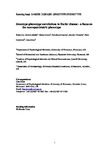Genotype-phenotype correlations in Darier disease: A focus on the neuropsychiatric phenotype
| dc.contributor.author | Gordon-Smith, K | |
| dc.contributor.author | Green, Elaine | |
| dc.contributor.author | Grozeva, D | |
| dc.contributor.author | Tavadia, S | |
| dc.contributor.author | Craddock, N | |
| dc.contributor.author | Jones, L | |
| dc.date.accessioned | 2018-10-27T08:52:34Z | |
| dc.date.issued | 2018-12 | |
| dc.identifier.issn | 1552-4841 | |
| dc.identifier.issn | 1552-485X | |
| dc.identifier.uri | http://hdl.handle.net/10026.1/12658 | |
| dc.description.abstract |
Darier disease (DD) is an autosomal dominant skin disorder caused by mutations in ATP2A2 encoding the sarco/endoplasmic reticulum Ca2+ ATPase Isoform 2 (SERCA2). Evidence of a population-level association between DD and psychiatric disorders suggests that mutations in ATP2A2 may have pleiotropic effects on the brain as well as skin. Evidence of genotype-phenotype relationships between ATP2A2 mutations and neuropsychiatric phenotypes would further support this suggestion. We investigated genotype-phenotype correlations between lifetime neuropsychiatric features and ATP2A2 mutation type (dichotomized into likely gene disrupting [LGD] or protein altering) in 75 unrelated individuals with DD. We also looked for evidence of clustering of mutations within SERCA2 according to neuropsychiatric features. Combining our data with the existing literature, the rate of LGD mutations was found to be significantly higher among DD cases/families with bipolar disorder, schizophrenia, or affective psychosis (p = .011). We also found a significant relationship between mutations located in the S4-M4 region of the protein and the presence of a severe neuropsychiatric phenotype (p = .032). Our findings add support to the hypothesis that Darier-causing mutations in ATP2A2 confer susceptibility to neuropsychiatric dysfunction, in particular severe psychiatric illness. This, together with evidence from research on common polymorphisms confirms ATP2A2 as a gene at which variation influences susceptibility to major psychiatric illness. | |
| dc.format.extent | 717-726 | |
| dc.format.medium | Print-Electronic | |
| dc.language | en | |
| dc.language.iso | en | |
| dc.publisher | Wiley | |
| dc.subject | Darier disease | |
| dc.subject | genotype-phenotype correlations | |
| dc.subject | neuropsychiatric features | |
| dc.title | Genotype-phenotype correlations in Darier disease: A focus on the neuropsychiatric phenotype | |
| dc.type | journal-article | |
| dc.type | Journal Article | |
| dc.type | Research Support, Non-U.S. Gov't | |
| plymouth.author-url | https://www.ncbi.nlm.nih.gov/pubmed/30345710 | |
| plymouth.issue | 8 | |
| plymouth.volume | 177 | |
| plymouth.publication-status | Published | |
| plymouth.journal | American Journal of Medical Genetics Part B: Neuropsychiatric Genetics | |
| dc.identifier.doi | 10.1002/ajmg.b.32679 | |
| plymouth.organisational-group | /Plymouth | |
| plymouth.organisational-group | /Plymouth/Faculty of Health | |
| plymouth.organisational-group | /Plymouth/REF 2021 Researchers by UoA | |
| plymouth.organisational-group | /Plymouth/REF 2021 Researchers by UoA/UoA01 Clinical Medicine | |
| plymouth.organisational-group | /Plymouth/REF 2021 Researchers by UoA/UoA01 Clinical Medicine/UoA01 Clinical Medicine | |
| plymouth.organisational-group | /Plymouth/Research Groups | |
| plymouth.organisational-group | /Plymouth/Research Groups/Institute of Translational and Stratified Medicine (ITSMED) | |
| plymouth.organisational-group | /Plymouth/Research Groups/Institute of Translational and Stratified Medicine (ITSMED)/CBR | |
| plymouth.organisational-group | /Plymouth/Users by role | |
| dc.publisher.place | United States | |
| dcterms.dateAccepted | 2018-08-01 | |
| dc.rights.embargodate | 2019-10-22 | |
| dc.identifier.eissn | 1552-485X | |
| dc.rights.embargoperiod | Not known | |
| rioxxterms.versionofrecord | 10.1002/ajmg.b.32679 | |
| rioxxterms.licenseref.uri | http://www.rioxx.net/licenses/all-rights-reserved | |
| rioxxterms.licenseref.startdate | 2018-12 | |
| rioxxterms.type | Journal Article/Review |


